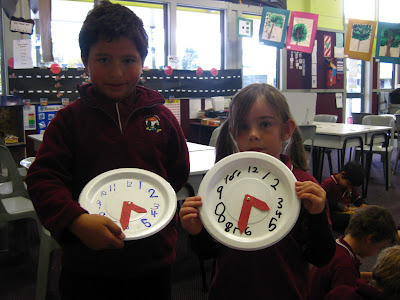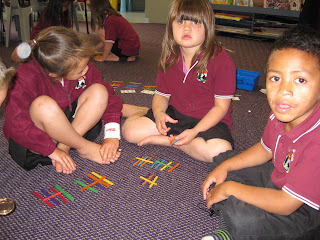Mathematics Term 3 2012
This term we are learning about fractions.
Mathematics Term 2 2012
This term the strand we are learning about is time.
We will also be learning about multiplication and division.
We have spent our first two weeks looking at time and almost everyone in the class can identify an o'clock time!
You will find our clock maths below and under that you will find some of our multiplication work. So scroll down and take a look.
This term we are learning about fractions.
Mathematics Term 2 2012
This term the strand we are learning about is time.
We will also be learning about multiplication and division.
We have spent our first two weeks looking at time and almost everyone in the class can identify an o'clock time!
You will find our clock maths below and under that you will find some of our multiplication work. So scroll down and take a look.
 |
| We made our own clocks using plastic plates. We had to write short and long on the hands. Then we used a split pin to attach our hands. We found it tricky work. We are feeling proud of our clocks. |
Just how many eyes do we have in our class?
Counting birds legs from our skip counting in 2s poem.
We are learning about addition and subtraction this term.
We are spending a lot of time practicing and competing to add two dice.
We are learning to recognise dice patterns without having to count them.
Some of us are learning to add the numbers together using a "counting on" strategy.
We play a great game called Lions & Tigers where we race to add fingers. Its lots of fun and it can get very loud when we play with lots of cheering each other on!
We have also been learning some bonds to 10 and some of us are learning our numbers to 10 or 20.
The strand in maths we are learning about this term is statistics. We have been playing a data collecting game based on the Handa's Surprise Book (you will find that story on our Online Books page).
In Term 1, Week 2, we started learning about tally marks. First we matched tally marks to cards.
Then we worked together in pairs making more tally marks with bunches of iceblock sticks.
Then we worked together in pairs making more tally marks with bunches of iceblock sticks.
We are learning about statistics (Term 1, Week 1)
On our first day of school and we learnt how to make a Pictogram also called a Pictograph.
First we drew all our family members on a Post-it-note and wrote the number of people in our family.
Then Mrs Griffin drew a graph and we put our pictures in the right places.
We talked about the information our Pictograph showed.
We know there are 7 people in our class who have 4 people in their family.
We have also made pictographs showing our favourite colours and foods we like. We know that pictographs show us information (data) using pictures. We could easily see what was the most popular or least popular colour in our class.
Class of 2011
We are learning problem solving skills with word problems. Mrs Griffin asked us if we had four cakes cut into four pieces, how many pieces would we have altogether? We could use whatever materials we thought we might need. Here are some photos of us solving the problem and our brainstorm at the end.
and we practised with more problems.
We are learning to add money; we used our skip counting knowledge to help us.We are learning about probability.
We have been thinking about how likely or unlikely some things are. We have been asking and answering questions like: "How likely is it to snow tomorrow?" or "How likely is it to get to 50 degrees Celcius today?"
We have decided that if it is 10 degrees Celcius, it is quite likely that we would wear our sweatshirts. When the temperature is 20 degrees Celcius it is quite likely that we would take our sweatshirts off. We figured this out because Mrs Griffin put a thermometer in our classroom so we can check each day what the temperature is. We already know that water freezes at 0 degrees and boils at 100 degrees, so we have been able to use that knowledge to help us make estimations about probability.
We are learning to see patterns and relationships.
We spent some time brainstorming and working in groups to show all the patterns we could think of.
Next time Mrs Griffin gave us 3 numbers and asked us to think of all the patterns we could make with those numbers. The numbers were 4, 6, 10.
What patterns can you make with those numbers?
 |
| Mrs Griffin was amazed at how quietly we all worked. |
 |
| We were proud of our ideas. |
 |
| We used our maths knowledge and strategies to help us. |
We have also discovered that doubles have a pattern - all the answers are even numbers and are counting in 2s. We found some patterns in our times tables facts as well. We found patterns on the 100s board too and we can predict what numbers might come next....
Addition and Subtraction - Number Lines Outside
Addition and Subtraction.
We had an answer, so how many equations could we find to match our answer? We had different ways of working this problem out, but we came up with lots of the same ideas.
 |
Learning to graph data with the story














%5B1%5D.jpg)
%5B1%5D.jpg)
.jpg)








































